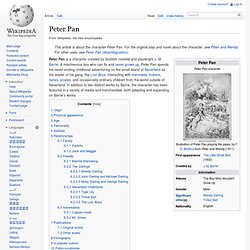

J. M. Barrie. Sir James Matthew Barrie, 1st Baronet, OM (9 May 1860 – 19 June 1937) was a Scottish author and dramatist, best remembered today as the creator of Peter Pan.

The child of a family of small-town weavers, he was educated in Scotland. He moved to London, where he developed a career as a novelist and playwright. There he met the Llewelyn Davies boys who inspired him in writing about a baby boy who has magical adventures in Kensington Gardens (included in The Little White Bird), then to write Peter Pan, or The Boy Who Wouldn't Grow Up, a "fairy play" about this ageless boy and an ordinary girl named Wendy who have adventures in the fantasy setting of Neverland. This play quickly overshadowed his previous work and although he continued to write successfully, it became his best-known work, credited with popularising the name Wendy, which was very uncommon previously.[1] Barrie unofficially adopted the Davies boys following the deaths of their parents. Childhood and adolescence[edit]
Sir J M Barrie. Born in Kirriemuir on 9 May 1860 in the house pictured here, James Mathew Barrie was the 9th child of a weaver.

Even as a child, he wrote for the school magazine and drama group (in which he also acted). He took a Master of Arts degree at Edinburgh University and after a short spell with the Nottingham Journal he moved to London in 1885. Barrie wrote for a number of papers and published his first book in 1887 and subsequent stories established his reputation and popularity. "Auld Licht Idylls" was a series of racy sketches of humble life in Kirriemuir (renamed 'Thrums' in the book, after the word in weaving for the ends of the warp threads). These stories began what was to become known, somewhat disparagingly, as the "Kailyard School" of Scottish fiction. A story "The Little White Bird" published in 1902 had ideas which Barrie carried forward to his best known work "Peter Pan".
J. M. Barrie. Sir James Matthew Barrie (1860 - 1937) J.

M. Barrie, the author who would not grow up, was born at 9 Brechin Road, Kirriemuir, Angus (the village he was to immortalize in his stories as 'Thrums'), the child of a Kirriemuir weaver, he was the second youngest of the 10 children. J. M. Barrie was educated at Glasgow Academy, Dumfries Academy and Edinburgh University. About 1900 it became apparent that Barrie's real flair was for drama. Barrie's chief virtues as a writer were the ability to delight and a firm grasp of the requirements of the stage, though in much of his work he was to present-day taste excessively sentimental and whimsical. Last comes the Hanky School, which was for the genteel and for the common who contemplated soaring. 'You will take something, Mr Cortachy?
' Walls, In Search of Scotland, University of Otago, New Zealand. John Buchan (1875-1940) Buchan was born in Perth in Scotland, the eldest of six siblings.

At the age of five he sustained a skull fracture in a carriage accident. The resulting scar is still clearly visible in the photograph above. Trained as a barrister, he found more success as a publisher, writer and politician. He himself said ‘Publishing is my business, writing an amusement and politics my duty.’ John Galt (1779-1839) Born in Irvine on the west coast of Scotland, Galt was a sickly child who stayed at home and despite his mother’s protestations, developed ‘bookish propensities’. Dame Muriel Spark (1918-2006) Muriel Sarah Camberg was born in Edinburgh, her father a Scottish Jew and her mother a Christian. Val McDermid Born in 1955, Val McDermid grew up in Kirkcaldy in Fife which is about 11 miles north of Edinburgh, as the crow flies, across the Firth of Forth.
McDermid also reviews for various British newspapers and writes for broadcast on BBC Radio 4 and BBC Radio Scotland. J. Peter Pan. Origin[edit] Cover of 1915 edition of J.

M. Barrie's novel, first published in 1911, illustrated by F. D. Bedford. Peter Pan first appeared in a section of The Little White Bird, a 1902 novel written by J.M Barrie for adults. The character's best-known adventure first appeared on 27 December 1904, in the form of a stage play entitled Peter Pan, or The Boy Who Wouldn't Grow Up. Following the success of the 1904 play, Barrie's publishers, Hodder and Stoughton, extracted chapters 13–18 of The Little White Bird and republished them in 1906 under the title Peter Pan in Kensington Gardens, with the addition of illustrations by Arthur Rackham.[1] Physical appearance[edit] In Peter Pan in Scarlet (released internationally in 2006), Geraldine McCaughrean adds to the description of his appearance, mentioning his blue eyes, and saying his hair is light (or at least any colour lighter than black).
Age[edit] The notion of a boy who would never grow up was based on J.M. Personality[edit] Abilities[edit] Peter Pan (2003. Peter Pan (1953. We Can Fly - Peter Pan (1953)